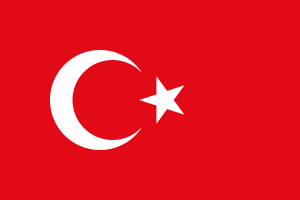Language/Turkish/Vocabulary/Cardinal-Numbers
 Հայերէն
Հայերէն Български език
Български език 官话
官话 官話
官話 Hrvatski jezik
Hrvatski jezik Český jazyk
Český jazyk Nederlands
Nederlands English
English Suomen kieli
Suomen kieli Français
Français Deutsch
Deutsch עברית
עברית हिन्दी
हिन्दी Magyar
Magyar Bahasa Indonesia
Bahasa Indonesia فارسی
فارسی Italiano
Italiano 日本語
日本語 Қазақ тілі
Қазақ тілі 한국어
한국어 Lietuvių kalba
Lietuvių kalba Νέα Ελληνικά
Νέα Ελληνικά Şimali Azərbaycanlılar
Şimali Azərbaycanlılar Język polski
Język polski Português
Português Limba Română
Limba Română Русский язык
Русский язык Српски
Српски Español
Español العربية القياسية
العربية القياسية Svenska
Svenska Wikang Tagalog
Wikang Tagalog தமிழ்
தமிழ் ภาษาไทย
ภาษาไทย Українська мова
Українська мова Urdu
Urdu Tiếng Việt
Tiếng Việt
| ◀️ Shopping — Previous Lesson | Next Lesson — Ordinal Numbers ▶️ |
Introduction[edit | edit source]
Welcome to the lesson on cardinal numbers in Turkish! In this lesson, you will learn how to count in Turkish and understand the concept of cardinal numbers. Numbers are an essential part of everyday life, and being able to count and understand numbers in Turkish will greatly enhance your language skills. So, let's get started!
Counting from 1 to 10[edit | edit source]
To begin, let's start with the numbers from 1 to 10. These numbers are fundamental in any language, and Turkish is no exception. Here are the Turkish numbers from 1 to 10:
| Turkish | Pronunciation | English |
|---|---|---|
| bir | [bir] | one |
| iki | [iki] | two |
| üç | [üç] | three |
| dört | [dört] | four |
| beş | [beş] | five |
| altı | [altɯ] | six |
| yedi | [jedi] | seven |
| sekiz | [sekiz] | eight |
| dokuz | [dokuz] | nine |
| on | [on] | ten |
Take some time to familiarize yourself with the pronunciation of these numbers. Practice saying them out loud until you feel comfortable with the sounds.
Counting from 11 to 100[edit | edit source]
Now that you know how to count from 1 to 10 in Turkish, let's move on to the numbers from 11 to 100. In Turkish, numbers from 11 to 19 have their own unique names, while numbers from 20 to 100 follow a pattern. Let's take a look:
Numbers from 11 to 19[edit | edit source]
In Turkish, numbers from 11 to 19 are formed by adding the suffix "-on" to the corresponding digit. For example:
- 11 is "on bir" [on bir]
- 12 is "on iki" [on iki]
- 13 is "on üç" [on üç]
- 14 is "on dört" [on dört]
- 15 is "on beş" [on beş]
- 16 is "on altı" [on altɯ]
- 17 is "on yedi" [on jedi]
- 18 is "on sekiz" [on sekiz]
- 19 is "on dokuz" [on dokuz]
Numbers from 20 to 100[edit | edit source]
In Turkish, numbers from 20 to 100 are formed by combining the ten's digit with the word for "yüz" [jyz], which means "hundred." Here are a few examples:
- 20 is "yirmi" [jɯɾmi]
- 30 is "otuz" [otuz]
- 40 is "kırk" [kɯɾk]
- 50 is "elli" [elli]
- 60 is "altmış" [altmɯʃ]
- 70 is "yetmiş" [yetmiʃ]
- 80 is "seksen" [seksen]
- 90 is "doksan" [doksan]
- 100 is "yüz" [jyz]
Take some time to practice saying these numbers out loud. Try to create your own examples using different ten's digits to reinforce your learning.
Counting Beyond 100[edit | edit source]
Now that you know how to count from 1 to 100 in Turkish, let's move on to counting beyond 100. The process is quite straightforward. We simply combine the hundred's digit with the ten's digit and the unit digit. For example:
- 101 is "yüz bir" [jyz bir]
- 126 is "yüz yirmi altı" [jyz jɯɾmi altɯ]
- 150 is "yüz elli" [jyz elli]
- 200 is "iki yüz" [iki jyz]
- 500 is "beş yüz" [beş jyz]
- 1000 is "bin" [bin]
As you can see, counting beyond 100 follows a similar pattern to the numbers from 20 to 100. Take some time to practice saying these numbers out loud and create your own examples to reinforce your learning.
Cardinal Numbers in Context[edit | edit source]
Numbers are not only used for counting, but they also play a crucial role in expressing quantities, measurements, and telling the time. Let's explore some examples of cardinal numbers in different contexts:
Quantities[edit | edit source]
- I have two cats. - "İki kediye sahibim."
- She ate three apples. - "Üç elma yedi."
- We bought five books. - "Beş kitap satın aldık."
Measurements[edit | edit source]
- The room is ten square meters. - "Oda on metrekare."
- The temperature is twenty degrees Celsius. - "Sıcaklık yirmi derece."
- He ran for thirty minutes. - "Otuz dakika koştu."
Telling the Time[edit | edit source]
- What time is it? - "Saat kaç?"
- It's one o'clock. - "Saat bir."
- The meeting is at three o'clock. - "Toplantı üçte."
- The train arrives at eight thirty. - "Tren sekiz otuzda varır."
Take note of the different structures used when expressing quantities, measurements, and telling the time in Turkish. Practice using cardinal numbers in these contexts to deepen your understanding.
Conclusion[edit | edit source]
Congratulations! You have successfully learned how to count in Turkish and understand cardinal numbers. Numbers are an essential part of any language, and mastering them will greatly enhance your communication skills. Practice saying the numbers out loud, create your own examples, and continue to reinforce your learning through everyday use. Keep up the great work!
Sources[edit | edit source]
- Turkish Numbers For Beginners – StoryLearning
- Turkish Lesson 10: Turkish Numbers
- Category:Turkish language - Wiktionary
Other Lessons[edit | edit source]
| ◀️ Shopping — Previous Lesson | Next Lesson — Ordinal Numbers ▶️ |

